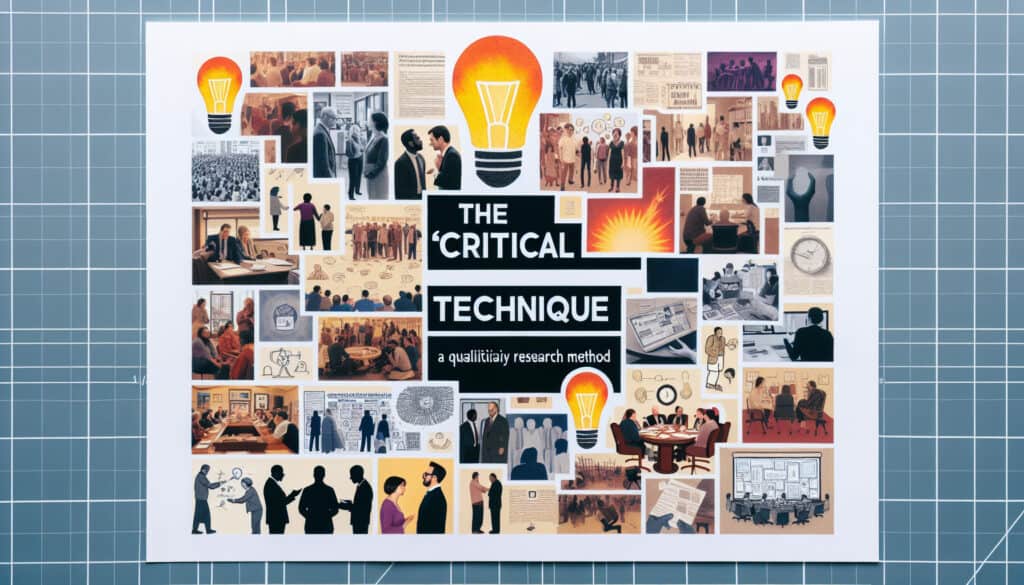Une recherche qualitative méthode qui implique la collecte d'informations détaillées sur des sujets importants du monde réel. événements (incidents) de la part d'observateurs ou de participants.
- Méthodologies : Clients et marketing, Économie, Lean Sigma, Fabrication, Gestion de projet, Qualité
Technique de l'incident critique

Technique de l'incident critique
- Amélioration continue, Conception pour Six Sigma (DfSS), Pensée conceptuelle, Interaction homme-machine, Gestion de la qualité, Utilisabilité, Tests d'utilisabilité, Expérience utilisateur (UX), User-Centered Design
Objectif :
Comment il est utilisé :
- Les enquêteurs demandent aux utilisateurs ou aux employés de décrire des cas spécifiques où ils ont connu un résultat particulièrement positif ou négatif lors de l'exécution d'une tâche, ainsi que le contexte et les conséquences.
Avantages
- Rassemble des données riches et contextualisées sur les comportements et les problèmes des utilisateurs dans le monde réel ; aide à identifier les facteurs clés qui conduisent au succès ou à l'échec ; fournit des exemples spécifiques pour l'amélioration de la conception ou de la formation.
Inconvénients
- repose sur la mémoire des participants, qui peut être inexacte ou biaisée ; les incidents peuvent être rares et ne pas être représentatifs d'une utilisation typique ; l'analyse des données qualitatives peut prendre beaucoup de temps.
Catégories :
- Ergonomie, Ressources humaines, Conception de Produits, Qualité
Idéal pour :
- Comprendre les facteurs clés qui contribuent à la réussite ou à l'échec de l'interaction d'un utilisateur avec un système.
La technique de l'incident critique (CIT) est particulièrement adaptable à la recherche sur l'expérience utilisateur, aux tests d'utilisabilité et aux évaluations de la productivité sur le lieu de travail dans divers secteurs, notamment les soins de santé, l'éducation, le développement de logiciels et le service à la clientèle. La méthodologie est souvent employée au cours des premières phases d'un projet pour éclairer les décisions de conception ou au cours des phases de tests itératifs pour affiner les systèmes existants. En règle générale, le CIT peut être lancé par des chercheurs en expérience utilisateur, des concepteurs de produits ou des ingénieurs en facteurs humains qui cherchent à recueillir des données qualitatives détaillées directement auprès des utilisateurs ou des employés. Les participants à cette méthodologie sont principalement des utilisateurs du produit ou du système en question, ainsi que des employés qui interagissent avec le processus, offrant ainsi un aperçu authentique de leurs expériences. Un exemple d'application dans le secteur des soins de santé pourrait consister à interroger des infirmières sur les incidents critiques qu'elles ont rencontrés lors de l'utilisation de systèmes de dossiers médicaux électroniques (DME), ce qui peut révéler des facteurs essentiels qui améliorent ou compromettent les soins aux patients en raison de problèmes de convivialité. En documentant les incidents positifs et négatifs, les équipes peuvent établir une compréhension claire des obstacles systémiques et des stratégies réussies qui conduisent à de meilleures interactions avec les utilisateurs, jetant ainsi les bases d'améliorations ciblées de la conception et d'initiatives de formation. Les données riches du monde réel obtenues grâce au CIT permettent aux organisations de prendre des décisions éclairées fondées sur les expériences réelles des utilisateurs plutôt que sur des hypothèses ou un retour d'information généralisé.
Principales étapes de cette méthodologie
- Identifier des tâches ou des interactions spécifiques à étudier.
- Inviter les utilisateurs ou les employés à se souvenir d'incidents significatifs liés à ces tâches.
- Encouragez l'élaboration du contexte de chaque incident.
- Demandez des détails sur les résultats et les conséquences des incidents.
- Explorer les sentiments et les pensées de l'utilisateur au cours de l'incident.
- Demandez des précisions sur ce qui a contribué à la réussite ou à l'échec de la situation.
- Analyser les incidents recueillis pour y déceler des thèmes et des schémas communs.
- Hiérarchiser les facteurs identifiés en fonction de leur impact sur l'expérience de l'utilisateur.
Conseils de pro
- Les questions de suivi permettent d'approfondir le contexte émotionnel et situationnel des incidents signalés, ce qui permet de mieux comprendre les motivations et les réactions des utilisateurs.
- Utiliser l'analyse thématique des incidents collectés pour découvrir des modèles et des tendances sous-jacents qui peuvent éclairer à la fois les choix de conception et les interventions de formation.
- Incorporer des sources de données multimodales (par exemple, données d'observation, analyse des tâches) aux entretiens sur les incidents afin de valider les résultats et de mettre en évidence les divergences entre les expériences perçues et réelles des utilisateurs.
Lire et comparer plusieurs méthodologies, nous recommandons le
> Référentiel méthodologique étendu <
ainsi que plus de 400 autres méthodologies.
Vos commentaires sur cette méthodologie ou des informations supplémentaires sont les bienvenus sur le site web de la Commission européenne. section des commentaires ci-dessous ↓ , ainsi que toute idée ou lien en rapport avec l'ingénierie.
Contexte historique
1962
1970
1972
1980
1980
1986
1986
1960
1963
1970
1980
1980
1980
1986
1987
(si la date est inconnue ou n'est pas pertinente, par exemple "mécanique des fluides", une estimation arrondie de son émergence notable est fournie)















Articles Similaires
Programme directeur de production (PDP)
Personnalisation de masse
Entonnoir marketing
Audit marketing
Indice MAPO (Mouvement et assistance des patients hospitalisés)
Planification des ressources de fabrication (MRP II)